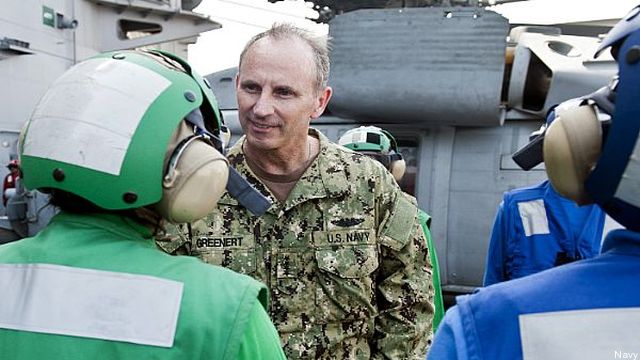CNO Says Navy Needs Ground Forces’ Help On Cyber, Electronic Warfare
Posted on

WASHINGTON: Rivalries between the services are a favorite topic in this town, especially when budgets tighten. But when it comes to cyberwarfare, electronic warfare, and the wireless world where they intersect, the Navy’s top man in uniform is more than happy to get help from the Army.
Admittedly, Adm. Jonathan Greenert is mostly focused on working with the Air Force on cyber/EW under the Air-Sea Battle concept and on reforming the Navy itself. He’s challenging the culture of “straight stick” naval aviators to admit that electronic warfare aircraft like the EA-18G Growler and E-2D Hawkeye are often more important than the strike fighters they support: The strike planes have to make through enemy air defenses to their targets, he noted, and — in a reflection of the Navy’s doubts about “low observable” technology — “all the stealth in the world ain’t gonna penetrate everything,” he told the audience at the 50th annual conference of the Association of Old Crows, a group named after a slang term for electronic warfare operators. Often, he added, a cyber attack or jamming can take down an enemy command network or stop an incoming missile far more effectively than any physical attack.
Greenert’s also jamming cyber and EW content into every training program from the Naval Academy to the Naval Postgraduate School. “Establishing a better awareness is number one,” he said. The CNO also pushed for Cyber Command, currently a part of Strategic Command and co-located with the National Security Agency at Fort Meade, be elevated to an independent “unified combatant command with global reach.” But when I asked Greenert about the Army and Marine Corps’ role on his way out, he made clear the ground forces can bring some things the Navy lacks.
“They have apertures that we haven’t yet developed yet,” Greenert stopped to tell me as his aides desperately tried to chivvy him along to his next appointment. “A ground node is very powerful.” Some radar, sensor, and electronic warfare systems are physically too big and power-hungry to fit on a ship, for example, and it’s hard to imagine taking a cluster of supercomputers like the one at Fort Meade and getting it to float. On the other hand, those megafacilities are, by definition, static. “A ship can move, but it doesn’t have the aperture and the bandwidth” of those big ground-based systems, Greenert said.
On the flipside, what the Navy brings that the Army doesn’t is strategic mobility. “If you’re an afloat unit, you can relocate anywhere around the world,” he told me. “It’s the site, the node that we’re moving around.”
True, the Army and Marines have plenty of smaller electronic warfare systems that can fit in a truck, and the Army in particular is fielding high-bandwidth networks. But those give up the raw power of permanent ground installations without gaining the mobility of shipboard systems. Ground forces may be tactically mobile, but strategically they’re merely deployable, requiring ships and planes to put them into position. A ship, by contrast, is the largest possible platform that can still move.
(The ability to move much larger things through the water than would be possible over land is a matter of physics that applies across the board: The largest marine mammals, blue whales, are much bigger than the largest land mammals, elephants.)
Greenert is hopeful that new technologies can bring the cyber/EW power of ships closer to that of permanent ground installations. (He didn’t mention specifics, but one is probably replacing today’s turbine engines with an all-electric drive). “When we get a shop that gets that tremendous amount of power [–] that’s in the future — and we miniaturize more, we’ll be that much more agile,” Greenert told me.
For a long time to come, however, ground units and installations will play a crucial role in supporting naval forces in an area of warfare that the CNO identifies as their highest priority.
Subscribe to our newsletter
Promotions, new products and sales. Directly to your inbox.
